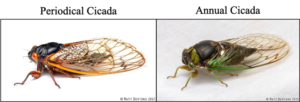By Bodhanaa Nithyananda, Seasonal Naturalist
Many people are surprised – and some alarmed – to hear that there will be cicadas in Ohio again this summer.
In fact, there are cicadas in Ohio EVERY summer! Just not like last year.
The cicadas we experienced last year were special 13- and 17-year periodical cicadas called Brood X, which only emerge once every 13 or 17 years. They typically have dark bodies, transparent wings, bright red eyes and are the genus Magicicada. They emerge in huge numbers as a group, called developmental synchronicity, in either 13-year or 17-year cycles, and at different times depending on where you live in Ohio. We won’t be seeing or hearing them again for a while, at least until the year 2034.
 The kind of cicadas emerging this summer are annual cicadas that come out individually every two or three years and will be around EVERY summer. These include genera Tibicen, Neocicada and Platypedia. Most annual cicada species are more camouflaged with dark eyes and are larger than the Brood X cicadas.
The kind of cicadas emerging this summer are annual cicadas that come out individually every two or three years and will be around EVERY summer. These include genera Tibicen, Neocicada and Platypedia. Most annual cicada species are more camouflaged with dark eyes and are larger than the Brood X cicadas.
You won’t hear the deafening male chorus like last year and may not even see an annual cicada. You may only hear a single buzz since they emerge one by one. Cicadas get their name from the Latin cicada which means “buzzer.” The word cicada almost sounds like the sound they make! Listen for the buzzing sound from July until September. The sound comes from the males because they have sound boxes in their abdomens. They make the buzzing sound by expanding and contracting a white ribbed membrane called a tymbal. They use their sound to attract females, which make clicking noises when they are ready to mate. The hotter the day, the louder the male cicadas will buzz.
The appearance of Sirius the Dog Star (part of the constellation Canis Major, The Greater Dog) rising with the sun starting July 3 this year, signals the start of the dog days of summer. The Romans were responsible for naming this 40 day time period from July 3 to August 11 ‘dog days’ because they thought the heat of Sirius contributed to the sultry heat of the summer. Annual cicadas are also called dog-day cicadas, when their buzzing starts in the early heat of July days and continues until evening as the sun sets.
Cicadas, sometimes erroneously called locusts, are from the order Hemiptera or true bugs, and have captured the attention of poets, artists, and musicians since at least ancient Greece. Poets like Virgil and Plato wrote about cicadas symbolizing death, re-birth and love. In 1936 a poem called “Locust lovers, attention!” by Ogden Nash appeared in the New Yorker. Bob Dylan wrote a song called “Day of the Locusts” referring to the sound of cicadas as he waited to receive an honorary degree from Princeton.
Cicadas are considered a beneficial species. As they move from the soil to the tree, they aerate the soil. They are an important food source not only for shrews and moles while underground, but birds and anything that has an insectivorous diet feed on the cicadas. Their dead bodies help the soil by providing nitrogen as they decompose. And guess what, they provide a solid source of protein for many humans around the world. You can eat them too, if you are not allergic to shellfish.
For me, the first buzz of the annual cicadas around the Fourth of July signals that summer has finally arrived, complete with the appearance of fireflies (Family Lampyridae) at the end of June. It’s finally time for the hammock, lemonade, and lazy afternoons lulled by the summery zzzzzzzZZZZZZZZZZZZzzzzzz coming from the treetops.






